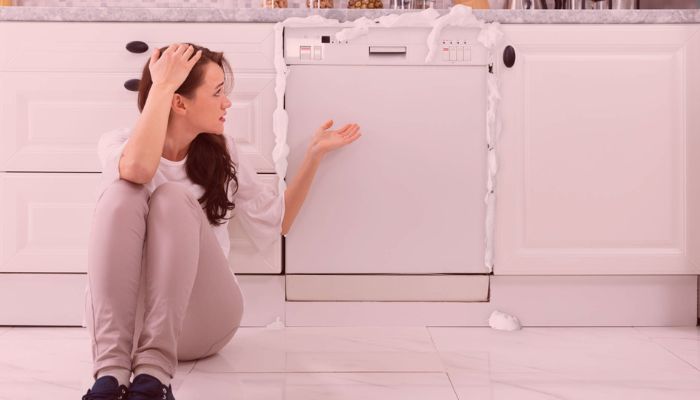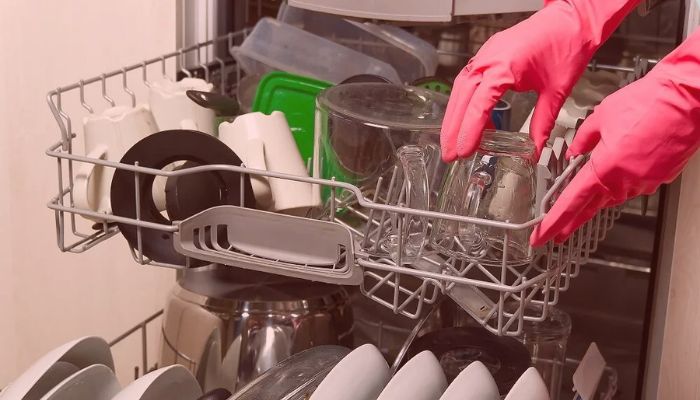Seeing suds in the dishwasher when you open the door can be frustrating. A dishwasher is designed to clean dishes efficiently, but excessive suds can interfere with its performance. If there are too many bubbles or soap foam inside the tub, it can lead to overflow, drainage problems, and even potential damage to the appliance.
The most common cause of this issue is using the wrong type or too much detergent. Regular dish soap is not meant for automatic dishwashers, and even dishwasher detergent in excessive amounts can cause excessive suds. Hard water can also contribute to detergent residue buildup, making the problem worse over time.
Addressing excess suds is important to keep the dishwasher running efficiently. Ignoring the problem can result in improper rinsing, detergent buildup, and potential damage to the pump or valve. Fortunately, there are simple steps to suppress the suds and help flush the soap through the dishwasher, restoring proper function.
Read this article till the end, as I am going to walk you through the causes, troubleshooting methods, and preventive tips for the suds in your dishwasher.

What Are the Causes of Suds in Your Dishwasher?
Wrong Type of Detergent
Using the wrong type of detergent is a leading cause of excess suds in a dishwasher. Dish soap, designed for handwashing, produces thick soap foam that can quickly lead to overflow.
Unlike dishwasher detergent, which is formulated to break down food and grease without creating excessive bubbles, dish soap and other non-compatible cleaners cause excess suds that disrupt the wash cycle and may even damage the appliance.
Too Much Detergent
Even when using the correct dishwasher detergent, adding too much can cause excessive suds. The amount of detergent should be based on the dishwasher manufacturer’s recommendations and water hardness level.
Using more than necessary can leave behind residue, create soap foam buildup, and reduce cleaning efficiency. In severe cases, too much detergent can cause the dishwasher to overflow, requiring a quick cycle with no detergent to flush out the excess.
Hard Water and Mineral Buildup
Hard water contains high levels of minerals such as calcium and magnesium, which interfere with detergent performance. These minerals prevent the detergent from dissolving properly, leading to a buildup that can cause excess suds over time.
Additionally, mineral deposits can clog the dishwasher’s interior components, affecting water flow and reducing rinse efficiency. A water softener may help minimize detergent residue and improve overall dishwasher performance.
Residual Soap on Dishes
Pre-washing dishes with dish soap before loading them into the dishwasher can introduce excess suds into the appliance. Many dish soaps leave a residue that interacts with dishwasher detergent, creating bubbles or soap foam during the wash cycle. Instead of pre-washing with soap, it’s best to scrape off food debris and allow the dishwasher to handle the cleaning.
Rinse Aid Dispenser Issues
Rinse agents help improve drying performance and prevent water spots, but improper use can contribute to suds formation. If the rinse aid dispenser leaks or dispenses too much product, it can mix with detergent in a way that leads to excess foam.
Checking the dispenser settings and ensuring it is functioning correctly can help reduce unnecessary suds in the dishwasher.
How Do You Get Rid of Suds in the Dishwasher?

Excessive suds in your dishwasher can disrupt the wash cycle and cause overflow. Here are some of the proven methods to get rid of suds in your dishwasher.
Turn Off the Dishwasher Cycle
As soon as you notice excess suds, turn off the dishwasher to prevent further soap foam buildup. Letting the cycle continue can cause overflow, leading to potential damage or water leaking onto the floor. Stopping the wash cycle immediately helps contain the issue and makes the cleaning process more manageable.
Clean Up Spilled Suds and Water
If suds or water have spilled out of the dishwasher, wipe them up quickly to avoid slipping hazards and prevent damage to nearby cabinets or flooring. Using a dry towel or sponge, soak up the bubbles and any standing water to minimize further mess.
Remove Excess Suds Manually
Scoop out as many suds as possible using a sponge or cloth. Regularly rinse and wring out the sponge to ensure effective removal. If necessary, remove the bottom dish rack to reach the detergent dispenser and tub area where suds may have accumulated.
Use Salt or Vinegar to Suppress the Suds and Help Flush the Soap
Sprinkling salt directly over the suds helps break them down, making it easier to rinse them away. Alternatively, pouring a mixture of vinegar and water into the dishwasher can help neutralize the foam. Both methods reduce excess suds and prepare the appliance for the next rinse cycle.
Run a Quick Cycle with No Detergent
Once the majority of suds have been removed, run a quick cycle with no detergent to flush out any remaining residue. This helps push soap through the dishwasher and ensures that no lingering bubbles affect the next wash. If suds persist, repeat the process until they are completely eliminated.
Wipe Down the Interior and Dispenser
After the rinse cycle, wipe down the interior of the dishwasher, including the detergent dispenser and door seals. This step removes any residual detergent or soap film that could cause future suds buildup. Pay attention to areas where detergent residue tends to accumulate.
Check for Proper Detergent Use Going Forward
To prevent excessive suds in the future, always use a detergent specifically designed for automatic dishwashers. Avoid using regular dish soap or too much detergent, as both can cause excessive foam.
If your home has hard water, consider using a water softener or adjusting detergent levels accordingly to reduce residue buildup.
What Are the Preventive Tips to Avoid the Recurrence of Suds in the Dishwasher?

Here are some effective ways to prevent suds in your dishwasher.
Use the Correct Detergent
Always select a detergent specifically formulated for dishwashers. Regular dish soap creates excessive foam, leading to overflow and poor wash performance. Check product labels to ensure compatibility with your dishwasher model.
Measure Detergent Properly
Follow the manufacturer’s recommended dosage to prevent over-sudsing. Using more detergent than necessary does not improve cleaning results and can lead to soap buildup, requiring extra rinse cycles to clear.
Address Hard Water Issues
Hard water can interfere with detergent effectiveness, leaving behind soap residues that contribute to suds. If you have hard water, use a dishwasher salt or water softener to prevent mineral buildup and improve detergent performance.
Avoid Pre-Washing with Dish Soap
Rinsing dishes with regular dish soap before loading them into the dishwasher can leave behind residue that reacts with the detergent, causing excess foam. Instead, scrape off food particles without using soap.
Perform Routine Maintenance
Regularly clean dishwasher filters, spray arms, and seals to remove soap buildup and grease. Running a cleaning cycle with vinegar or a dishwasher cleaner can help prevent suds-related issues.
Check for Residual Soap on Dishes
Ensure dishes are free from dish soap or handwashing detergent before placing them in the dishwasher. Residual soap from pre-washed dishes can mix with dishwasher detergent, creating excessive foam.
Conclusion
Addressing suds in your dishwasher is essential for maintaining its efficiency and preventing potential damage. The most common causes of excessive suds include using the wrong type of detergent, adding too much, or dealing with hard water residue. Pre-washing dishes with soap and rinse aid dispenser issues can also contribute to the problem.
If your dishwasher is overflowing with soap foam, immediate steps such as stopping the cycle, manually removing suds, and running a rinse cycle without detergent can help restore normal operation. Using salt or vinegar can also assist in breaking down excess bubbles.
To prevent future suds buildup, always use the correct dishwasher detergent, measure it properly, and address hard water issues. Regular maintenance, including cleaning the filters and checking for residual soap on dishes, ensures a trouble-free dishwashing experience.
FAQs
How do I stop suds from overflowing in my dishwasher?
Turn off the dishwasher immediately to prevent further suds buildup. Wipe up any spilled water to avoid floor damage. Remove excess suds manually, then run a short rinse cycle with vinegar or salt to break down the foam. Repeat if necessary to clear all remaining soap residue.
Can I use regular dish soap in my dishwasher?
No, regular dish soap creates excessive suds that can overflow and cause drainage problems. Dishwashers require low-sudsing detergent specifically formulated for automatic washing. Using dish soap can lead to soap buildup, poor rinsing, and potential damage to the appliance’s internal components over time.
What can I use to break down suds in my dishwasher?
Sprinkling salt over the suds helps break them down quickly. Vinegar neutralizes soap foam and helps rinse away residue. A small amount of cooking oil can also be used to reduce bubbles, but it should be followed by a rinse cycle to remove any oily residue.
